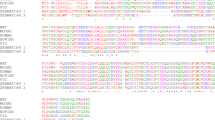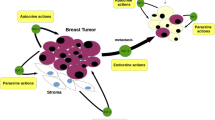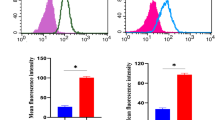Abstract
The human IGFBP family consists of at least seven proteins, designated as IGFBP-1, -2, -3, -4, -5, -6, and-7. IGFBPs 1-6 bind IGF-I and IGF-II with high affinity whereas IGFBP-7, a newly identified IGFBP, binds IGFs with lower affinity and constitutes a low-affinity member of the IGFBP family. IGFBPs serve to transport the IGFs, prolong their half-lives, and modulate their biological action. At the cellular level, IGFBPs can either potentiate or inhibit the mitogenic effects of IGFs, depending upon cell types and IGFBP species (IGF-dependent action of IGFBPs). However, recent studies have indicated that IGFBPs, especially IGFBP-3, potently inhibit breast cancer cell growth in an IGF-independent manner. The IGF-independent action of IGFBP-3 requires interaction with cell-surface association proteins, presumably putative IGFBP-3 specific receptors, and is responsible for growth inhibitory action of the known growth suppressing factors such as TGF-β, retinoic acid, and antiestrogens in breast cancer cells. Thus, IGFBP-3 appears to be a major factor in a negative control system involved in regulating human breast cancer cell growth in vitro. IGFBP-7, representing a low affinity IGFBP, appears to function as an IGF-independent cell growth regulator in breast cancer cells. Overall structural similarity between IGFBP-7 and classical high affinity IGFBPs 1-6 suggests that the mechanisms of action and signaling pathways used by IGFBP-7 may provide insight into the IGF-independent actions of the high affinity IGFBPs.
A fuller understanding of the IGF-independent action of IGFBPs will allow us to understand how the growth of neoplastic cells can be modulated by the IGF/IGFBP system, and how other growth factors or pharmacological agents can interface with this system.
Similar content being viewed by others
References
Salmon WD, Daughaday WH: A hormonally controlled serum factor which stimulates sulfate incorporation by cartilage in vitro. J Lab Clin Med 49:825–836, 1957
Daughaday WH, Hall K, Raben MS, Salmon WD, Van den Brande JLV, Van Wyk JJ: Somatomedin: Proposed designation for sulphation factor. Nature 235:107, 1972
Daughaday WH, Rotwein P: Insulin-like growth factors I and II. Peptide, messenger ribonucleic acid and gene structures, serum and tissue concentrations. Endocrine Rev 10:68–91, 1989
Rosenfeld RG, Lamson GL, Pham H, Oh Y, Conover C, DeLeon DD, Donovan SM, Ocrant I, Giudice LC: Insulin-like growth factor-binding proteins. Rec Progr Horm Res 46:99–159, 1991
Baxter RC, Martin JL: Binding proteins for the insulin-like growth factors: structure, regulation and function. Progr Growth Factor Res 1:49–68, 1989
Jones JL, Clemmons DR: Insulin-like growth factors and their binding proteins: biological actions. Endocrine Rev 16:3–34, 1995
Oh Y, Muller HL, Neely EK, Lamson G, Rosenfeld RG: New concepts in insulin-like growth factor receptor physiology. Growth Regul 3:113–123, 1993
Werner H, Woloschak M, Stannard B, Shen-Orr Z, Roberts CT Jr, LeRoith D: The insulin-like growth factor receptor, molecular biology, heterogencity and regulation. In: LeRoith D (ed) Insulin-like Growth Factors: Molecular and Cellular Aspects. CRC Press, Boca Raton FL, 1991, pp 17–47
Lowe L: Biological actions of the insulin-like growth factors. In: LeRoith D (ed) Insulin-like Growth Factors: Molecular and Cellular Aspects. CRC Press, Boca Raton FL, 1991, pp 49–85
Kelley KM, Oh Y, Gargosky SE, Gucev Z, Matsumoto T, Hwa V, Ng L, Simpson D, Rosenfeld RG: Insulin-like growth factor-binding proteins (IGFBPs) and their regulatory dynamics. Int J Biochem Cell Biol 28:619–637, 1995
Jones JI, Clemmons DR: Insulin-like growth factors and their binding proteins: biological actions. Endocrine Rev 16:3–34, 1995
Swisshelm K, Ryan K, Tsuchiya K, Sager R: Enhanced expression of an insulin growth factor-like binding protein (mac25) in senescent human mammary epithelial cells and induced with retinoic acid. Proc Natl Acad of Sci USA 92:4472–4476, 1995
Oh Y, Nagalla SN, Yamanaka Y, Kim H, Wilson L, Rosenfeld RG: Identification and characterization of insulin-like growth factor binding protein (IGFBP)-7: recombinant human mac25 protein specifically binds IGF-I and-II. J Biol Chem 271:30322–30325, 1996
Osborne CK, Coronado EB, Kitten LJ, Artcaga CI, Fuqua SAW, Ramasharma K, Marshall M, Li CH: Insulin-like growth factor II (IGF-II): a potential autocrine/paracrine growth factor for human breast cancer acting via the IGF-I receptor. Mol Endocrinol 3:1701–1709, 1989
De Leon DD, Wilson DM, Powers M, Rosenfeld RG: Effects of insulin-like growth factors (IGFs) and IGF receptor antibodies on the proliferation of human breast cancer cells. Growth Factors 6:327–336, 1992
Furlanetto RW, DiCarlo JN: Somatomedin C receptors and growth effects in human breast cancer cells maintained in long-term culture. Cancer Res 44:2122–2128, 1984
Huff KK, Kaufman D, Gabbay KH, Spencer EM, Lippman ME, Dickson RB: Human breast cancer cells secrete an insulin-like growth factor-1-related polypeptide. Cancer Res 46:4613–4619, 1986
Westley B, May FEB: IGFs and control of cell proliferation in human breast and other cancers. Reviews on Endocrine-Related Cancer 39:29–34, 1991
Baxter RC, Maitland JE, Raisur RL, Reddel R, Sutherland RL: High molecular weight somatomedin-C (IGF-I) from T47D human mammary carcinoma cells: immunoreactivity and bioactivity. In: Spencer EM (ed) Insulin-like Growth Factors/Somatomedins. De Gruyter, Berlin, 1983, pp 615–618
Cullen KJ, Smith HS, Hill S, Rosen N, Lippman ME, Yee D: Growth factor mRNA expression by human breast fibroblasts from benign and malignant lesions. Cancer Res 51:4978–4985, 1991
Paik S: Expression of IGF-I and IGF-II mRNA in breast tissue. Breast Cancer Res Treat 22:31–38, 1992
Cullen KJ, Yee D, Sly WS, Perduc J, Hampton B, Lippman ME, Rosen N: Insulin-like growth factor receptor expression and function in human breast cancer. Cancer Res 50:48–53, 1990
Bonneterre J, Peyrat JP, Beuscart R, Demaille A: Prognostic significance of insulin-like growth factor receptors in human breast cancer. Cancer Res 50:6931–6935, 1990
Peyrat JP, Bonneterre J: The type 1 IGF receptor in human breast diseases. Breast Cancer Res Treat 22:59–67, 1992
De Leon DD, Bakker B, Wilson DM, Hintz RL, Rosenfeld RG: Demonstration of insulin-like growth factor (IGF-I and-II) receptors and binding proteins in human breast cancer cell lines. Biochem Biophys Res Commun 152:398–405, 1988
Papa V, Hartmann KKP, Rosenthal SM, Maddux BA, Siiteri PK, Goldfine ID: Progestins induce down regulation of insulin-like growth factor I (IGF-I) receptors in human breast cancer cells: potential autocrine role of IGF-II. Mol Endocrinol 5:709–717, 1991
Colletti RB, Roberts JD, Devlin JT, Copeland KC: Effect of tamoxifen on plasma insulin-like growth factor I in patients with breast cancer. Cancer Res 49:1882–1884, 1989
Reed MJ, Christodoulides A, Koistinen R, Seppala M, Teale JD, Ghilchik MW: The effect of endocrine therapy with medroxyprogesterone acetate, 4-hydroxyandrostenedione or tamoxifen on plasma concentrations of insulin-like growth factor (IGF)-I, IGF-II and IGFBP-1 in women with advanced breast cancer. Int J Cancer 52:208–212, 1992
Pollak MN, Huynh HT, Lefebvre SP: Tamoxifen reduces serum insulin-like growth factor I (IGF-I). Breast Cancer Res Treat 22:91–100, 1992
Pollak MN: Effects of adjuvant tamoxifen therapy on growth hormone and insulin-like growth factor I (IGF-I) physiology. In: Salmon SE (ed) Adjuvant Therapy of Cancer VII. Lippincott, 1993, pp 43–53
Lamson G, Giudice LC, Rosenfeld RG: Insulin-like growth factor binding proteins: Structural and molecular relationships. Growth Factors 5:19–28, 1991
Figueroa JA, Jackson JG, McGuire WL, Krywicki RF, Yee D: Expression of insulin-like growth factor binding proteins in human breast cancer correlates with estrogen receptor status. J Cell Biochem 52:196–205, 1993
Rosenfeld RG: Somatomedin action and tissue growth-factor receptors. In: Robbins RJ, Mclmcd S (eds) Acromegaly. Plenum Press, New York, 1987, pp 45–53
Neely EK, Beukers WM, Oh Y, Cohen P, Rosenfeld RG: Insulin-like growth factor receptors. Acta Pediatr Scand [Suppl] 372:116–123, 1991
Oh Y, Muller HL, Neely EK, Lamson G, Rosenfeld RG: New concepts in insulin-like growth factor receptor physiology. Growth Regul 3:113–123, 1993
Hintz RL, Liu F: Demonstration of specific plasma protein binding sites for somatomedin. J Clin Endocrinol Metab 45:988–982, 1977
Baxter RC, Martin JL, Tayler MI, Howden MEH: Growth hormone dependent insulin like growth factor (IGF) binding protein from human plasma differs from other human IGF binding proteins. Biochem Biophys Res Commun 139:1256–1259, 1986
Guler HP, Zapf J, Schmid C, Froesch ER: Insulin-like growth factors I and II in healthy man. Estimations of half-lives and production rates. Acta Endocrinol (Copenh) 121:753–758, 1989
Baxter RC, Martin JL: Binding proteins for the insulin-like growth factors: structure, regulation, and function. Prog Growth Factor Res 1:49–56, 1989
Martin JL, Coverley JA, Pattison ST, Baxter RC: Insulin-like growth factor-binding protein-3 production by MCF-7 breast cancer cells: Stimulation by retinoic acid and cyclic adenosine monophosphate and differential effects of estradiol. Endocrinology 136:1219–1226, 1995
Paik S: Expression of IGF-I and IGF-II mRNA in breast tissue. Breast Cancer Res Treat 22:31–38, 1992
Pratt SE, Pollak MN: Estrogen and antiestrogen modulation of MCF-7 human breast cancer cell proliferation is associated with specific alterations in accumulation of insulin-like growth factor-binding proteins in conditioned media. Cancer Res 53:5193–5198, 1993
Capony F, Rougeot C, Montcourrier P, Cavailles V, Salazar G, Rochefort H: Increased secretion, altered processing and glycosylation of pro-cathepsin D in human mammary cancer cells. Cancer Res 49:3904–3909, 1989
Conover CA, De Leon DD: Acid-activated insulin-like growth factor binding protein 3 proteolysis in normal and transformed cells. Role of cathepsin D. J Biol Chem 269:7076–7080, 1994
Yu H, Diamandis EP, Sutherland DJA: Immunoreactive prostate-specific antigen levels in female and male breast tumors and its association with steroid hormone receptors and patient age. Clinical Biochem 27:75–79, 1994
Cohen P, Graves HCB, Peehl DM, Kamarei M, Giudice LC, Rosenfeld RG: Prostate specific antigen (PSA) is an IGF binding protein-3 (IGFBP-3) protease found in seminal plasma. J Clin Endocrinol Metab 75:1046–1053, 1993
Schmitt M, Goretzki L, Janicke F, Calvete J, Eulitz M, Kobayashi H, Chucholowski N, Graeff H: Biological and clinical relevance of the urokinase-type plasminogen activator in breast cancer. Biomedica Biochimica Acta 50:731–741, 1991
Lee DY, Park SK, Yorgin PD, Cohen P, Oh Y, Rosenfeld RG: Alteration of insulin-like growth factor-binding proteins (IGFBPs) and IGFBP-3 protease activity in serum and urine from acute and chronic renal failure. J Clin Endocrinol Metab 79:1376–1382, 1994.
Cohen P, Peehl DM, Lamson G, Rosenfeld RG: Insulin-like growth factors (IGFs), IGF receptors and IGF binding proteins in primary cultures of prostate epithelial cells. J Clin Endocrinol Metab 73:401–407, 1991
Lalou C, Lassarre C, Binoux M: A proteolytic fragment of insulin-like growth factor (IGF) binding protein-3 that fails to bind IGFs inhibits the mitogenic effects of IGF-I and insulin. Endocrinology 137:3206–3212, 1996
Pratt SE, Pollak MN: Estrogen and antiestrogen modulation of MCF-7 human breast cancer cell proliferation is associated with specific alterations in accumulation of insulin-like growth factor-binding proteins in conditioned media. Cancer Res 53:5193–5198, 1993
Pratt SE, Pollak MN: Insulin-like growth factor binding protein 3 (IGFBP-3) inhibits estrogen-stimulated breast cancer cell proliferation. Biochem Biophys Res Commun 198:292–297, 1994
Oh Y, Muller HL, Lamson G, Rosenfeld RG: Insulin-like growth factor (IGF)-independent action of IGF-binding protein-3 in Hs578T human breast cancer cells. J Biol Chem 268:14964–14971, 1993
Oh Y, Muller HL, Pham HM, Rosenfeld RG: Demonstration of receptors for insulin-like growth factor binding protein-3 on Hs578T human breast cancer cells. J Biol Chem 268:26045–26048, 1993
Oh Y, Müller HL, Ng L, Rosenfeld RG: TGF-β-induced cell growth inhibition in human breast cancer cells is mediated through IGFBP-3 action. J Biol Chem 270:13589–13592, 1995
Gucev ZS, Kelley KM, Rosenfeld RG, Oh Y: Insulin-like growth factor binding protein-3 (IGFBP-3) mediates retinoic acid (RA)-and transforming growth factor-β2 (TGF-β2)-induced growth inhibition in human breast cancer cells. Cancer Res 56:1545–1550, 1996
Oh Y, Muller HL, Pham HM, Lamson G, Rosenfeld RG: Non-receptor mediated, post-transcriptional regulation of insulin-like growth factor binding protein (IGFBP)-3 in Hs578T human breast cancer cells. Endocrinology 131:3123–3125, 1992
Kraus MH, Yuasa Y, Aaronson SA: A position 12-activated H-ras oncogene in all Hs578T mammary carcinosarcoma cells but not normal mammary cells of the same patient. Biochem 81:5384–5388, 1984
Kozma S, Boggard M, Buser K, Saurer S, Bos J, Groner B, Hynes N: The human c-Kirsten ras gene is activated by a novel mutation in codon 13 in the breast carcinorma cell line MDA-MD-231. Nucleic Acids Res 15:5963–5970, 1987
Davidson NE, Gelmann EP, Lippman ME, Dickson RB: Epidermal growth factor receptor gene expression in estrogen receptor positive and negative human breast cancer cell lines. Mol Endocrinol 1:216–223, 1987
Yamanaka Y, Fowlkes JL, Rosenfeld RG, Oh Y: Characterization of insulin-like growth factor binding protein-3 (IGFBP-3) binding to human breast cancer cells. J Biol Chem (submitted), 1997
Knabbe C, Lippman ME, Wakefield LM, Flanders KC, Kasid A, Derynck R, Dickson RB: Evidence that transforming growth factor-beta is a hormonally regulated negative growth factor in human breast cancer cells. Cell 48:417–428, 1987
Fontana JA, Burrows-Mczu A, Clemmons DR, LeRoith D: Retinoid modulation of insulin-like growth factor-binding proteins and inhibition of breast carcinoma proliferation. Endocrinology 128:1115–1122, 1990
Martin JL, Ballesteros M, Baxter RC: Insulin-like growth factor-I (IGF-I) and transforming growth factor-beta 1 release IGF-binding protein-3 from human fibroblasts by different mechanisms. Endocrinology crinology 131:1703–1710, 1992
San Roman GA, Magoffin DA: Insulin-like growth factor binding proteins in ovarian follicles from women with polycystic ovarian disease: cellular source and levels in follicular fluid. J Clin Endocrinol Metab 75:1010–1016, 1992
Huynli H, Yang X, Pollak M: Estradiol and antiestrogens regulate a growth inhibitory insulin-like growth factor binding protein 3 autocrine loop in human breast cancer cells. J Biol Chem 271:1016–1021, 1996
Valentinis B, Bhala A, DeAngelis T, Baserga R, Cohen P: The human insulin-like growth factor (IGF) binding protein-3 inhibits cell growth of fibroblasts with a targeted disruption of the IGF-I receptor gene. Mol Endocrinol 9:361–367, 1995
Delbe J, Blat C, Desauty G, Harel L: Presence of IDF45 (mIGFBP-3) binding sites on chick embryo fibroblasts. Biochem Biophys Res Commun 179:495–501, 1991
Andreatta-Van Leyen S, Hembree JR, Eckert RL: Regulation of insulin-like growth factor binding protein 3 levels by epidermal growth factor and retinoic acid in cervical epithelial cells. J Cell Physiol 160:265–274, 1994
Buckbinder L, Talbott R, Velasco-Miguel S, Takenaka I, Faha B, Seizinger BR, Kley N: Induction of the growth inhibitor IGF-binding protein 3 by p53. Nature 377:646–649, 1995
Wilson EM, Oh Y, Rosenfeld RG: Generation and characterization of an IGFBP-7 antibody: Identification of 31-kDa IGFBP-7 in human biological fluids and Hs578T human breast cancer conditioned media. J Clin Endocrinol Metab 82:1301–1303, 1997
Author information
Authors and Affiliations
Rights and permissions
About this article
Cite this article
Oh, Y. Igf-independent regulation of breast cancer growth by IGF binding proteins. Breast Cancer Res Treat 47, 283–293 (1998). https://doi.org/10.1023/A:1005911319432
Issue Date:
DOI: https://doi.org/10.1023/A:1005911319432




